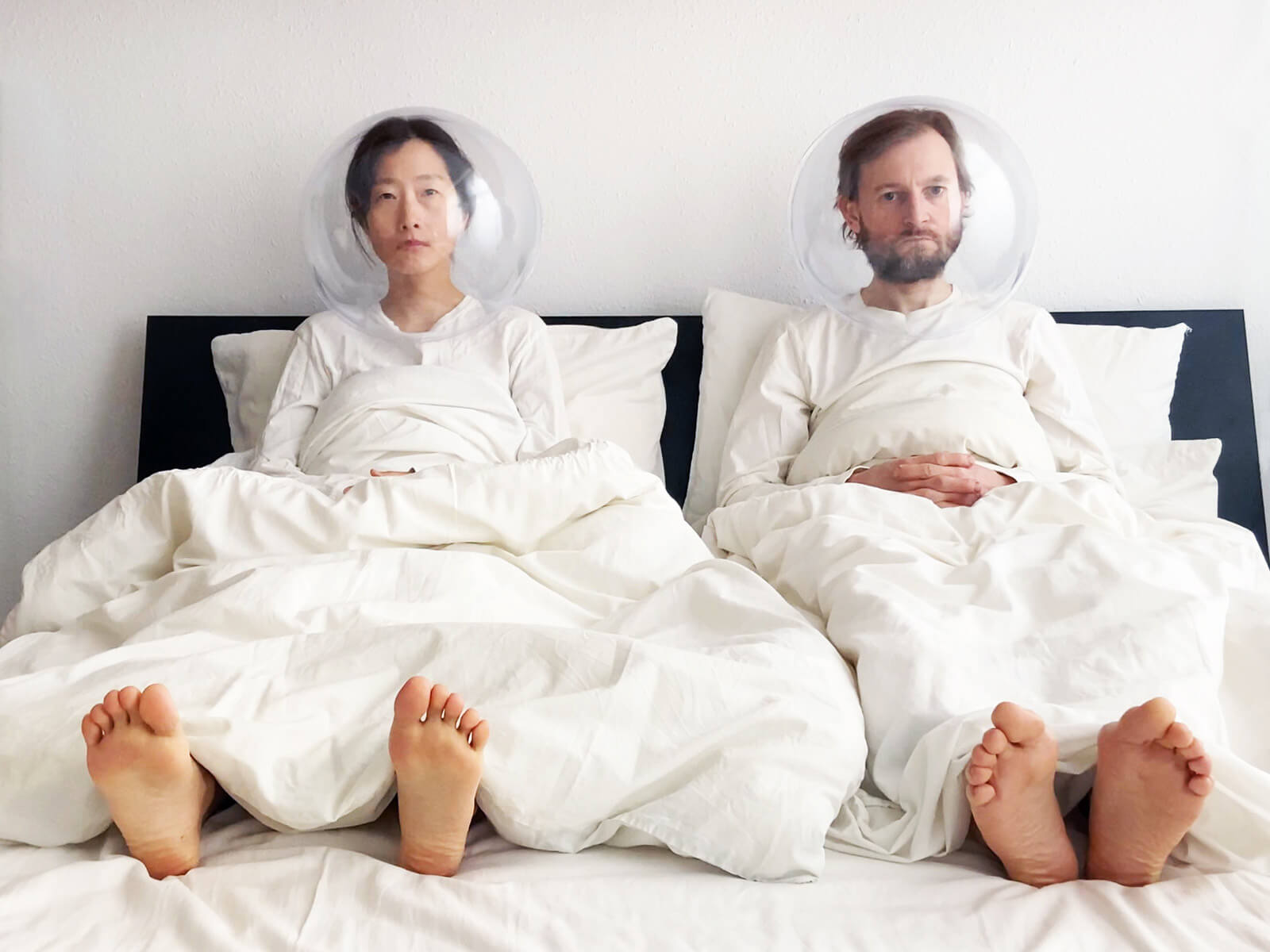Design in Quarantine
TDE in conversation with the founders of the online archive.

Plastique Fantastique, ‘iSphere’ face shield, 2020
COURTESY: Plastique Fantastique / PHOTOGRAPH: Marco Barotti
WE ALL KNOW that we are living through a period of major historical significance, which will shape the world in ways we have yet to fully discover. During Zoom conversations, over socially-distanced cups of tea, through personalised face masks, we have all heard it said. In one way or another everyone has had to adapt to the ‘new normal’ and the design community has responded in a typically creative manner.
Some designers have sought to create solutions to the novel challenges presented by the pandemic, others have simply used their practice as an invaluable form of expression in difficult times. In any case, the designs that have emerged from the pandemic have been incredibly varied, ranging from social distancing hats to 40 metre-wide world memorials to the pandemic – and of course a proliferation of fashionable face-masks.

JPA Design, ‘Loop’ hand sanitiser dispenser, 2020
COURTESY: JPA Design
Anna Talley and Fleur Elkerton, two design historians, took it upon themselves to document the burgeoning design responses to the COVID-19 pandemic. Together they created Design in Quarantine in an attempt to document the impact of the current global crisis upon design and designers in real time. TDE sat – at a safe distance – with Anna and Fleur to discuss the project.

Plastique Fantastique, ‘Mobile Personal Protective Space’, 2020
COURTESY: Plastique Fantastique / PHOTOGRAPH: Marco Barotti
The Design Edit (TDE): What was your first post on the archive?
Anna Talley (AT): It was the cover of the Guardian Weekly magazine. It was one of the first things I remember coming out that was that visually arresting, a graphic interpretation of what was going on.
TDE: What criteria does a design response need to meet to be included in the archive?
Fleur Elkerton (FE): The collecting criteria is really anything that qualifies as design, as long as it isn’t offensive. There are some things we have included that are more ‘speculative’, but they are still a valid design response. The purpose of the archive is to present as many objects and projects as objectively as possible, so people can look through and take from it what they want – they can learn things, be inspired or just explore and draw their own conclusions.

Alberto Ghirardello, ‘Primo Maggio’, 2020. ‘Primo Maggio’ refers to the traditional Italian barbecue that usually takes place on May 1st. This design incorporates the wooden barbecue skewers that were left unused, due to lockdown.
COURTESY: Alberto Ghirardello
-
Alberto Ghirardello, ‘Primo Maggio’, 2020 (detail)
COURTESY: Alberto Ghirardello
-
Wooden barbeque skewers used in ‘Primo Maggio’
COURTESY: Alberto Ghirardello
TDE: What are some of the more ‘speculative’ designs that you have included in the archive?
AT: One design I remember in particular was this mask-suit for clubbing, it looked like a spacesuit that would keep you safe from coronavirus. I can really imagine someone designing it because they were thinking, “I just really wish I could go and dance to some Daft Punk right now!”

Production Club, ‘Micrashell’, 2020
COURTESY: Production Club

Production Club, ‘Micrashell’, 2020
COURTESY: Production Club
TDE: What is your favourite design response on the archive?
FE: Mine is the ‘Green Screen Backdrop’, the screen has one plain green side which is professional and the other, more colourful, represents the designer. It fascinated me because a year ago it wouldn’t have made much sense to any of us, yet today it speaks to issues which most of us will have encountered, that is, how to translate your personality over a screen whilst living in a digital world and how to adapt to your home becoming your place of work.
AT: I would say the ‘Walking Stick’. It’s a one-off design that I love because of its elegance and simplicity. While walking, the brass rings transfer the movements of whoever you’re walking with into your hands, creating the feeling of holding hands. I think this object speaks to the way design and technology have been conduits for human connection throughout the virus.

Center for Optimism, Clara Meister and Sam Chermayeff, ‘Walking Stick’, 2020, made by Simon Ertl
COURTESY: Center for Optimism, Clara Meister and Sam Chermayeff, Ertl & Zull!
TDE: One post on the archive is a link to the ‘corona-grifting’ debate, a design phenomenon that emerged in response to the pandemic, what is your understanding of this phenomenon?
FE: I see it as a kind of greenwashing, trying to propose some kind of ‘innovative’ design idea or solution that isn’t for truly altruistic purposes. It might be for the promotion of the designer, or more for the sake of creating a design rather than creating a solution.
Broadly speaking, it’s those responses that haven’t been particularly well thought out and it might seem as though that object has just been designed for the sake of it.

Designlibero, ‘Bubble Shield’, 2020
COURTESY: Bubble Shield
TDE: Kate Wagner – the architecture and cultural critic who coined the term ‘corona-grifting’ – has been very critical of designers who she deems to have exploited the pandemic for self-promotion with designs that provide “little to no material benefit to those at risk”. But is there no value in design for the sake of design that is expressive/beautiful?
AT: I’ve always been interested in challenging the idea of corona-grifting. In her article, Kate Wagner seems to suggest that designers should be volunteering to provide genuine solutions to the pandemic. But I would argue that as a designer, the benefit of these designs comes from the cathartic practice of designing. I wonder whether she uses too broad a brushstroke when she says these designs have no use beyond selfish promotional purposes. Rather, we can say these designs are at least somewhat beneficial for the designer who is making them, in order to deal with the pandemic by doing what they do best – designing.
FE: I suppose it comes down to this idea that design and designers should provide solutions to the problems we are facing. I think what we can learn from corona-grifting is to question whether design exists only to provide innovative solutions to a problem.

Christophe Gernigon, ‘Plex’eat’, 2020
COURTESY: Christophe Gernigon Studio
TDE: How have these objects included in the archive been transformed into expressive objects beyond their clear functionality?
FE: These objects are a sign of the difficult times we’ve lived through. In that respect, there’s a lot to be said for those objects that are a little bit silly and a little bit whimsical that help you navigate life during the pandemic, to lighten the load and experience of what we’re going through.
AT: These objects represent something that we all have a personal connection to and understanding of. The idea of social distancing, for example, is not an idea that is limited to a certain country or group of people. In the future, we can look back at these remnants of a time period that speak to this shared experience.
-
Anna Talley
COURTESY: Design in Quarantine
-
Fleur Elkerton
COURTESY: Design in Quarantine
Anna and Fleur are continuing to upload new designs to the DiQ archive and publishing their monthly newsletter. They also continue to present their work at various academic conferences and forums. Anna is now preparing for her PhD which will begin in the autumn, while working with Design Pavilion in New York on their annual installation. Fleur will be working with the David Parr House museum in Cambridge as the lead in Digital Engagement and Content Creation. Alongside DiQ, Fleur curates an Instagram collection called Sustainable Histories showcasing objects that display repair, reuse or material innovation – follow the link below to the V&A blog to hear her talk more about the collection.











